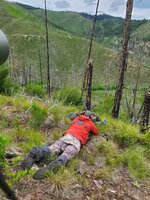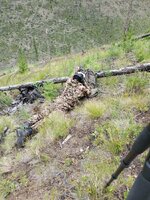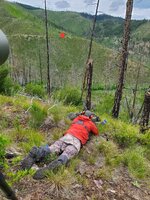A few weeks back
@BearGuy , myself and 9 buddies took to the hills for our now annual field shooting "competition". I started this shoot last year after wanting to see for myself what hit rates are under slight stress in the mountains. It's not pretty.
A quick summary
The shoot was 12 targets 100yds - 810yds. 3 points for a first round impact 1pt for a second. Each shot was +/- 2moa. Each shot started with full kit on. Each shot was timed with varying times per shot. All ranging, dialing, etc had to be done on the timer. As if you are hunting. Once you locate the animal and decide to shoot it. The time and pressure start.
I tried to vary each shot in distance, angle, and shooting position.
Between the 11 guys we had the full gamut of hunters. Full time guides, killers, new hunters, and experienced casual hunters.
View attachment 902946
@BearGuy shooting a 12" plate at 620yds with a 10 - 15mph gusty wind. The position was quite awkward with feet higher than your head. No one hit this target.
Conclusion
The combined first round hit rate as a whole was 28%. Most shots could be taken prone. I tried to make it so this wouldn't happen but I failed. All but 3 could be shot from prone. The guy who won finished with 17pts. Myself and a buddy finished tied 2nd with 14pts. The first half had light wind that could be mostly accounted for by holding edge of plate. The second half of the targets were in or across a main valley and had a strong 10-15mph wind that would gust over 20mph or more. Then switched 180° the last target. Overall wind was very challenging.
My take aways
- calling wind is a learned art form. It separates the men from the boys.
- spotting impacts in your scope is a necessity. Where I failed was seeing your miss isn't much help in something like this unless you have practiced quickly and accurately making a correction and applying it. I would see the miss and fumble my way to a wrong correction.
- Mil scopes are the way.
- suppressors are the way.
- my shooting was abysmal. I choked on any shot that wasn't prone. I let the timer get in my head. Many stages I finished with 30+ seconds to spare. Being fast does no good if you miss.
- this is my big one. I'm sorry if it's long winded. Just becouse you have a light recoiling, rokstocked, suppressed rifle with a FFP Mil mil scope. Means very little if you can't keep your self together and brake good shots under pressure. Ones practice must be very very intentional. Shooting prone on a known range, even under a timer, does not and will not help on the mountain past a certain point. If you want to increase proficiency on a mountain than you need to shoot in the mountains, get training, or be very diligent and proactive in your personal time to shoot sitting, kneeling, standing, and whatever on a timer. Be realalistic and thoughtful with your range time and figure out how to improve your precision and efficiency of movement and time.
- focused practice is needed
Sorry this is long. I find this stuff fascinating. Hope you get something from it.






